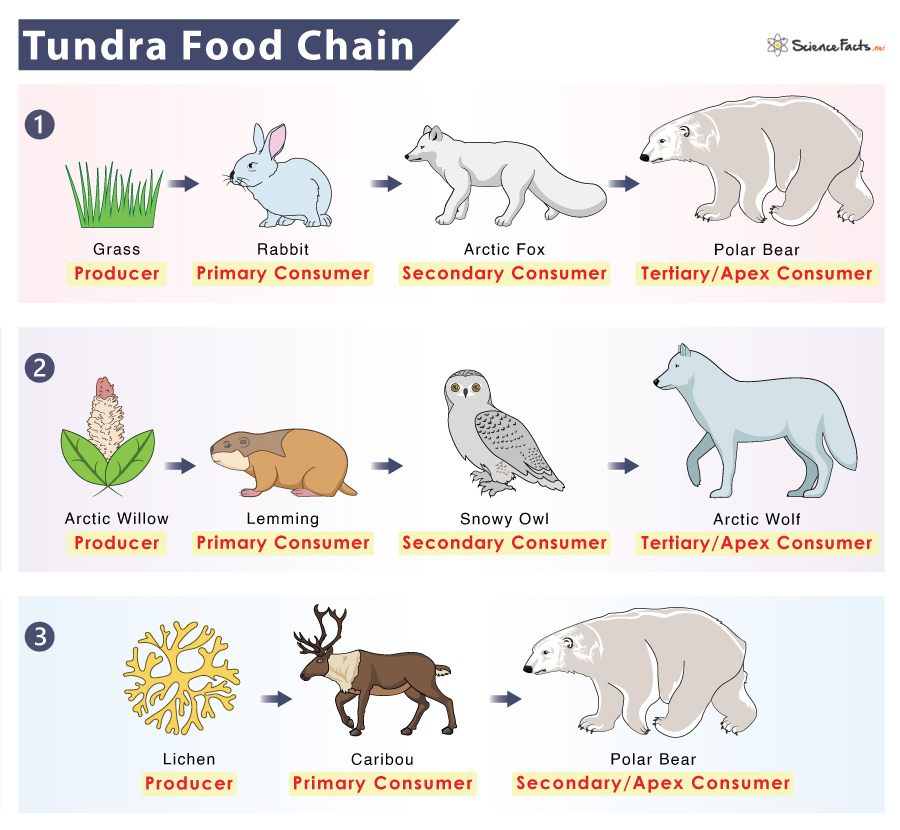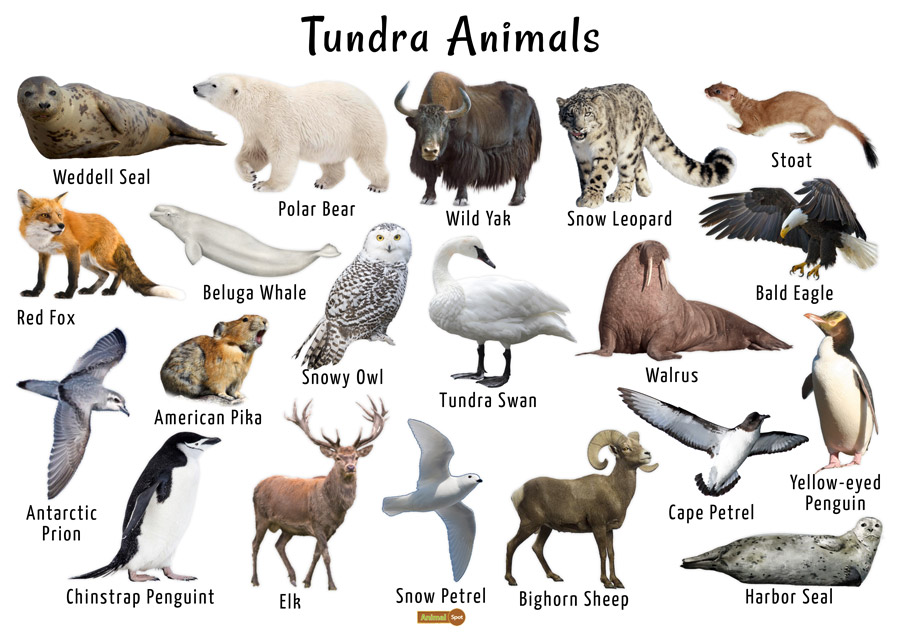Topic food chain in the ocean ecosystem: Explore the intricate web of life beneath the waves, where the "Food Chain in the Ocean Ecosystem" reveals a world of interconnected survival, from tiny plankton to majestic apex predators.
Table of Content
- What are the different levels in the food chain of the ocean ecosystem?
- Levels of the Food Chain
- Alternative Food Chains
- Introduction to the Ocean Ecosystem
- Primary Producers in the Ocean
- Herbivores: The Second Tier of the Food Chain
- YOUTUBE: Exploring Ecosystems: Coastal Food Webs
- Carnivores and Their Role in the Ocean
- Apex Predators: The Top of the Food Chain
- Alternative Food Chains: Deep Ocean Ecosystems
- Human Impact on Ocean Food Chains
- Conservation Efforts to Protect Marine Life
What are the different levels in the food chain of the ocean ecosystem?
In the ocean ecosystem, the food chain consists of several levels:
- Primary Producers: These are the organisms that form the base of the food chain. They include phytoplankton and algae, which undergo photosynthesis to produce energy from sunlight.
- Primary Consumers: These are the organisms that directly feed on the primary producers. They include zooplankton, small fish, and crustaceans that consume phytoplankton and algae.
- Secondary Consumers: These are the organisms that feed on the primary consumers. They can be larger fish, sharks, or marine mammals that prey on the smaller fish and crustaceans.
- Tertiary Consumers: These are the organisms that feed on the secondary consumers. They include apex predators like killer whales or large sharks that are at the top of the ocean food chain.
- Decomposers: These organisms break down the remains of dead organisms (both plants and animals) and recycle the nutrients back into the ecosystem. They include bacteria, fungi, and detritus feeders.
It\'s important to note that the ocean food chain is not always a linear progression, as some organisms may have multiple feeding interactions and occupy different trophic levels depending on their diet and behavior.
READ MORE:
Levels of the Food Chain
- Primary Producers (Level One)
- Phytoplankton and other one-celled organisms, along with coastal seaweed and seagrasses, are the base of the food chain, converting sunlight into energy.
- Herbivores (Level Two)
- These include zooplankton, small fish, and larger animals like green turtles and manatees, which feed on the ocean"s plant life.
- Carnivores (Level Three)
- Small carnivores such as sardines and herring, and larger predators like octopuses, feed on smaller animals and invertebrates.
- Top Predators (Level Four)
- Apex predators include sharks, dolphins, and seals, which are crucial for maintaining the balance of marine ecosystems.
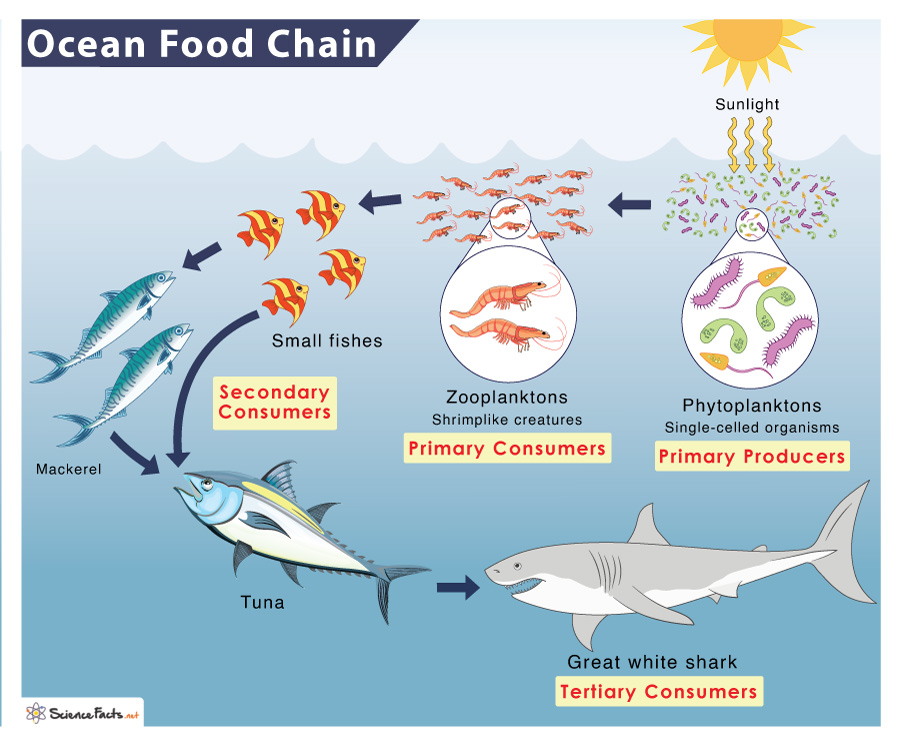
Alternative Food Chains
Deep-ocean ecosystems independent of sunlight are fueled by chemical energy from sources like hydrothermal vents, showcasing the diversity of the ocean"s food web.
Introduction to the Ocean Ecosystem
The ocean ecosystem is a vast and intricate network of living organisms and their physical environment, interconnected through a complex web of ecological relationships. It encompasses a variety of habitats, from the shallow coastal waters to the deep-sea trenches, each supporting a unique array of life. The foundation of this ecosystem is the myriad of microscopic plants and bacteria, such as phytoplankton, that populate the sunlit upper layers of the ocean. These primary producers harness the sun"s energy to create organic compounds through photosynthesis, forming the base of the ocean food chain.
Herbivorous animals, including zooplankton, small fish, and various marine mammals, consume these primary producers, transferring energy up the food chain. Carnivores, such as larger fish, seals, and sharks, then feed on these herbivores, further circulating nutrients and energy through the ecosystem. Apex predators, sitting at the top of this food chain, play a crucial role in maintaining the balance of marine life by regulating the populations of other species.
Beyond its biological components, the ocean ecosystem plays a pivotal role in regulating the Earth"s climate, cycling nutrients, and supporting a wealth of human activities. Ocean currents distribute heat around the globe, while marine organisms contribute significantly to the carbon cycle, helping to absorb carbon dioxide from the atmosphere. This dynamic system not only supports marine life but also has a profound impact on terrestrial ecosystems and human societies, providing essential resources, recreational opportunities, and economic benefits.
However, human activities have increasingly impacted the ocean ecosystem, leading to challenges such as pollution, overfishing, and climate change. These issues threaten the delicate balance of marine life and the myriad services the ocean provides. Conservation efforts and sustainable management practices are crucial to protecting this invaluable ecosystem for future generations.

Primary Producers in the Ocean
The ocean"s primary producers form the foundation of the marine food chain, playing a critical role in the global carbon cycle and producing a significant portion of the Earth"s oxygen. These organisms include a vast array of photosynthetic plants and bacteria that convert sunlight, carbon dioxide, and nutrients into organic matter through the process of photosynthesis.
- Phytoplankton: Tiny, photosynthetic organisms that float in the sunlit upper layers of the ocean. They are the most abundant and widespread primary producers in the marine environment.
- Seaweeds: Larger, multicellular plants that live attached to rock or other hard substrata in coastal areas. They include various species such as kelps, which form underwater forests providing habitat and food for diverse marine species.
- Seagrasses: Flowering plants that form dense underwater meadows in shallow, sandy areas. Seagrasses are important for stabilizing sediments and supporting a diverse range of marine life.
These primary producers are not only vital for the marine food web, where they serve as the primary source of food for a variety of herbivores, but also contribute to the oxygen we breathe. More than half of the oxygen in the atmosphere is produced by phytoplankton through photosynthesis. Additionally, they play a significant role in sequestering carbon dioxide, thereby mitigating the effects of climate change.
The health and productivity of primary producers are influenced by various factors, including water temperature, nutrient availability, and sunlight. Changes in these conditions can significantly impact marine ecosystems, affecting everything from primary production rates to the distribution of species higher up in the food chain.
Herbivores: The Second Tier of the Food Chain
In the vast and biodiverse tapestry of the ocean ecosystem, herbivores constitute the second tier of the food chain, directly consuming the primary producers. These organisms are crucial for transferring the sun"s energy, captured by phytoplankton and other autotrophs, up the food chain to higher trophic levels. Herbivores in the ocean come in various forms, from microscopic zooplankton to large marine mammals.
- Zooplankton: Many species of zooplankton, though some are omnivorous, primarily feed on phytoplankton. They include copepods and krill, which are critical food sources for a wide range of marine species.
- Small Fish: Numerous small fish species, such as the parrotfish and surgeonfish, graze on algae and are fundamental in controlling algal populations and maintaining the health of coral reefs.
- Marine Mammals: Some marine mammals, like the manatee and green sea turtles, feed on seagrasses and algae, playing a key role in the health and stability of their habitats.
Herbivores perform a critical ecological service by regulating the growth of primary producers, which can otherwise grow out of control and lead to harmful algal blooms that deplete the water"s oxygen and disrupt the marine environment. By consuming plants and algae, these herbivores not only maintain the balance of the ecosystem but also act as a vital link between the primary producers and the higher trophic levels, including carnivores and apex predators.
The distribution and abundance of herbivores in the ocean are influenced by a variety of factors, including the availability of food resources, predation pressure, and environmental conditions. Changes in the population of herbivores can have significant downstream effects on the structure and function of marine ecosystems, highlighting their importance in the ocean food chain.
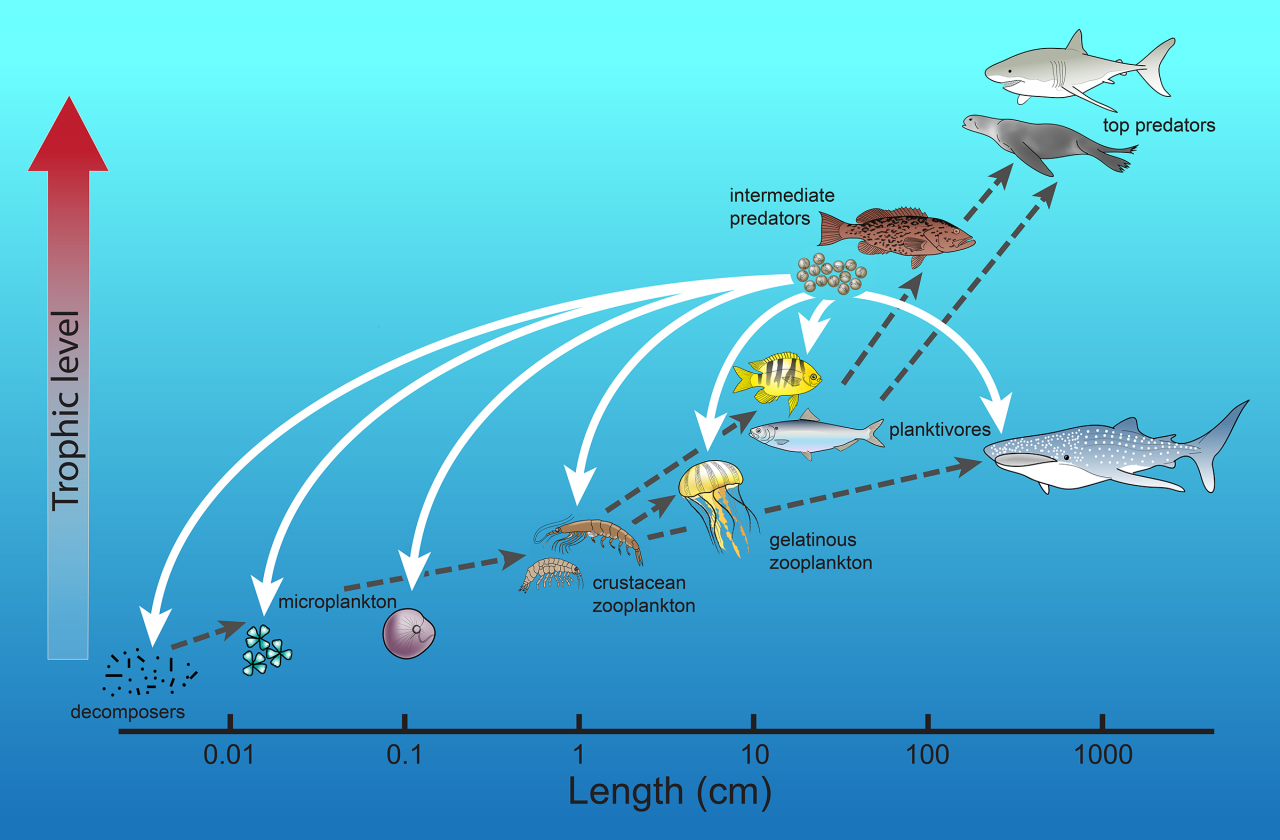
Exploring Ecosystems: Coastal Food Webs
Discover the mesmerizing world of coastal food webs and witness the intricate balance of life in this captivating video. From tiny plankton to majestic marine predators, prepare to be amazed by the incredible diversity and interconnectedness of coastal ecosystems.
Carnivores and Their Role in the Ocean
Carnivores play a pivotal role in maintaining the balance and health of ocean ecosystems. Occupying various levels within the food chain, marine carnivores range from small fish that feed on invertebrates to large predators that dominate the top of the food chain. These creatures are essential for controlling the population sizes of other marine animals, thereby preventing any single species from overwhelming the ecosystem.
- Small to Medium Fish: Many species of fish, such as the lionfish and groupers, prey on smaller fish and invertebrates. They play a crucial role in maintaining healthy populations of their prey and preventing the overgrazing of primary producers.
- Marine Mammals: Dolphins, seals, and whales consume a variety of prey, including fish, squid, and crustaceans. Their hunting strategies and dietary preferences have significant impacts on the structure of marine communities.
- Sharks and Large Predators: Apex predators like sharks play a crucial role in the ocean by regulating the populations of other marine animals and ensuring species diversity. Their presence indicates a healthy ocean ecosystem.
Carnivores also contribute to the nutrient cycle within the ocean. Through their feeding activities, they help to distribute nutrients across different areas, supporting the growth of primary producers and ensuring the health of coral reefs and other marine habitats. Furthermore, the presence of top predators can influence the behavior and distribution of prey species, leading to a more diverse and balanced ecosystem.
However, many marine carnivores are facing threats from overfishing, habitat loss, and pollution, which can lead to imbalances in the marine food web. Protecting these vital members of the ocean ecosystem through conservation efforts and sustainable fishing practices is essential for maintaining the health and diversity of marine life.
The Ocean Food Chain: Turtle\'s Guide to the Pacific
Dive into the enchanting realm of sea turtles and embark on an extraordinary journey alongside these ancient creatures. Watch as they gracefully swim through the crystal-clear waters and learn about their remarkable adaptations and the challenges they face in this awe-inspiring video.
Apex Predators: The Top of the Food Chain
Apex predators sit at the pinnacle of the oceanic food chain, playing a critical role in maintaining the health and balance of marine ecosystems. These predators are at the top because they have no natural predators of their own. They include a diverse group of species that regulate the populations of other marine organisms, thereby preventing any single species from dominating and altering the habitat in a way that could destabilize the ecosystem.
- Sharks: Sharks, such as the great white, hammerhead, and tiger shark, are quintessential apex predators, controlling populations of various marine species and ensuring healthy oceanic ecosystems.
- Orca Whales: Also known as killer whales, orcas are highly intelligent and versatile predators that feed on fish, seals, and even large whales, playing a key role in marine environments around the world.
- Large Seals: Species like the leopard seal are apex predators in some regions, preying on penguins, smaller seals, and fish, significantly influencing their prey populations.
Apex predators help to maintain biodiversity by keeping certain species from becoming too numerous, thus allowing a wider range of species to thrive. Their hunting activity is crucial for the removal of weak and sick individuals, thereby helping to ensure the genetic health of prey populations.
Despite their importance, many apex predators are threatened by human activities, including overfishing, habitat loss, and pollution, leading to declining populations in some areas. Protecting these species is essential for preserving the intricate balance of marine ecosystems and the overall health of our oceans.

Alternative Food Chains: Deep Ocean Ecosystems
Deep ocean ecosystems present a stark contrast to the sunlit, photosynthesis-driven food webs familiar in surface waters. These remote habitats, characterized by darkness, high pressure, and cold temperatures, host unique food chains that rely not on sunlight but on chemosynthesis for primary production. Here, the base of the food chain is formed by microorganisms that harness chemical energy from hydrothermal vents and cold seeps, providing energy and nutrients to a diverse community of deep-sea creatures.
- Hydrothermal Vents: At these spots on the ocean floor, chemosynthetic bacteria convert minerals and chemicals from the Earth"s crust into energy, supporting a variety of life, including tube worms, clams, and unique species of fish and crustaceans.
- Cold Seeps: Similar to hydrothermal vents, cold seeps release methane and other hydrocarbons, which are utilized by chemosynthetic bacteria. These bacteria form the basis of the food web, supporting life in these nutrient-poor environments.
- Whale Falls: The carcasses of dead whales sinking to the seafloor create ephemeral ecosystems that support deep-sea life for years, providing a boon of resources that sustains a complex hierarchy of scavengers, predators, and decomposers.
These alternative food chains demonstrate the adaptability and diversity of life in the ocean, revealing ecosystems that thrive independent of sunlight. The organisms in these environments exhibit remarkable adaptations to extreme conditions, including symbiotic relationships with chemosynthetic bacteria, specialized feeding strategies, and unique physiological traits to withstand the pressures of the deep sea.
Understanding these deep ocean ecosystems is crucial for appreciating the full complexity of marine life and the resilience of life forms in adapting to some of the Earth"s most extreme habitats. Moreover, these ecosystems highlight the importance of conserving oceanic environments, many aspects of which remain largely unexplored and understood.
Human Impact on Ocean Food Chains
Human activities have profoundly impacted ocean food chains, altering the balance of marine ecosystems worldwide. From overfishing to pollution, climate change, and habitat destruction, the cumulative effects of these actions have disrupted the intricate web of life that sustains the ocean"s biodiversity. Understanding these impacts is crucial for developing strategies to mitigate harm and protect marine life.
- Overfishing: One of the most direct human impacts, overfishing has depleted fish stocks, removing key predators and competitors and leading to imbalances in marine populations. This not only affects the targeted species but also the entire network of organisms that depend on them.
- Pollution: Chemicals, plastics, and other pollutants released into the ocean harm marine life at all levels of the food chain. Plastics ingested by small organisms can accumulate and magnify up the food chain, affecting the health of larger predators and even humans.
- Climate Change: Rising ocean temperatures and acidification affect the distribution and abundance of marine species. Coral bleaching, a direct result of warming waters, destroys the habitats of many species, while acidification impairs the ability of organisms like shellfish and plankton to form shells, impacting higher trophic levels.
- Habitat Destruction: Activities such as bottom trawling, coastal development, and the destruction of mangroves and seagrasses remove critical breeding and feeding grounds for many species, further straining food web dynamics.
The conservation and sustainable management of marine resources are essential to reversing the negative impacts of human activity on ocean food chains. This includes establishing marine protected areas, enforcing sustainable fishing practices, reducing pollution, and taking global action to mitigate climate change. By safeguarding marine ecosystems, we can preserve their biodiversity and ensure their resilience in the face of human-induced pressures.
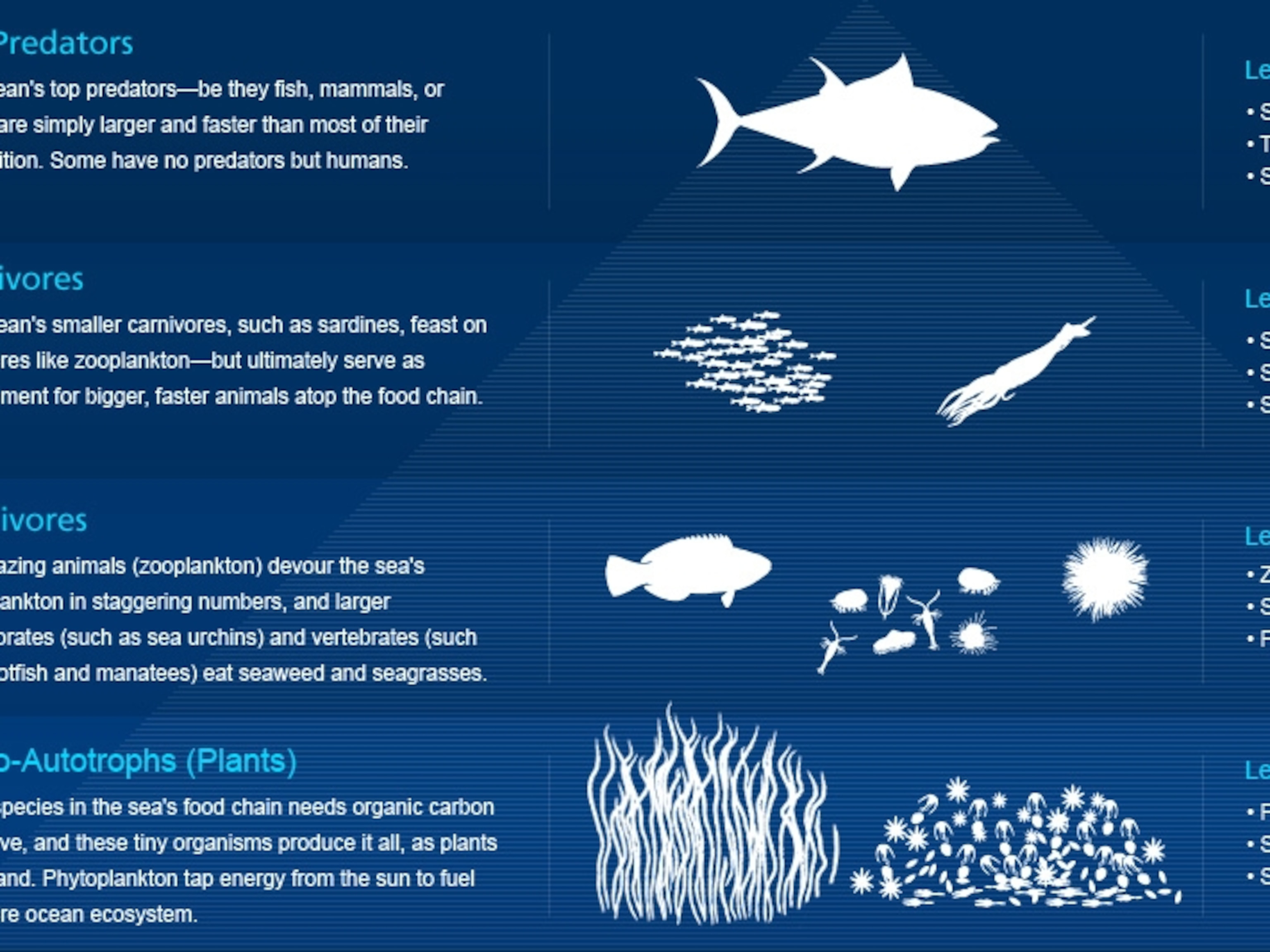
READ MORE:
Conservation Efforts to Protect Marine Life
Conservation efforts to protect marine life are crucial in combating the adverse effects of human activities on the ocean"s ecosystems. Governments, NGOs, and communities worldwide are implementing various strategies to preserve marine biodiversity, ensure sustainable use of its resources, and protect the health of ocean habitats. These efforts include:
- Establishing Marine Protected Areas (MPAs): MPAs limit human activities in designated ocean regions to protect ecosystems, habitats, and species. They serve as safe havens for marine life, helping to restore fish stocks and preserve biodiversity.
- Enforcing Sustainable Fishing Practices: Regulations such as catch limits, gear restrictions, and the prohibition of destructive fishing methods are essential to prevent overfishing and ensure the long-term sustainability of fish populations.
- Combating Pollution: Initiatives to reduce ocean pollution focus on minimizing plastic waste, controlling chemical runoff, and improving waste management on land to prevent harmful substances from reaching the ocean.
- Addressing Climate Change: Global efforts to reduce greenhouse gas emissions are vital to mitigating ocean warming and acidification. Protecting and restoring blue carbon ecosystems, such as mangroves, seagrasses, and salt marshes, also contribute to carbon sequestration.
- Research and Monitoring: Scientific research and regular monitoring of marine ecosystems are essential for understanding changes, assessing the effectiveness of conservation measures, and adapting strategies as needed.
These conservation efforts require international cooperation, adequate funding, and the involvement of local communities to be effective. By working together, we can ensure the protection of marine life and the preservation of the ocean"s health for future generations.
Explore the intricate web of life beneath the waves in our deep dive into the ocean"s food chain. Discover how every creature, from the smallest plankton to the largest predator, plays a vital role in the marine ecosystem"s delicate balance. Join us on this fascinating journey to uncover the secrets of the ocean and learn how we can all contribute to its preservation for future generations.
:max_bytes(150000):strip_icc()/489034241_5-56af62885f9b58b7d0183204.jpg)


:max_bytes(150000):strip_icc()/497408077-56af61ff3df78cf772c3c309.jpg)





:max_bytes(150000):strip_icc()/tundra-58bf1be55f9b58af5cc29755.jpg)
:max_bytes(150000):strip_icc()/GettyImages-901482062-6470b1099c6a47a881f9a22d7bca0d0a.jpg)
